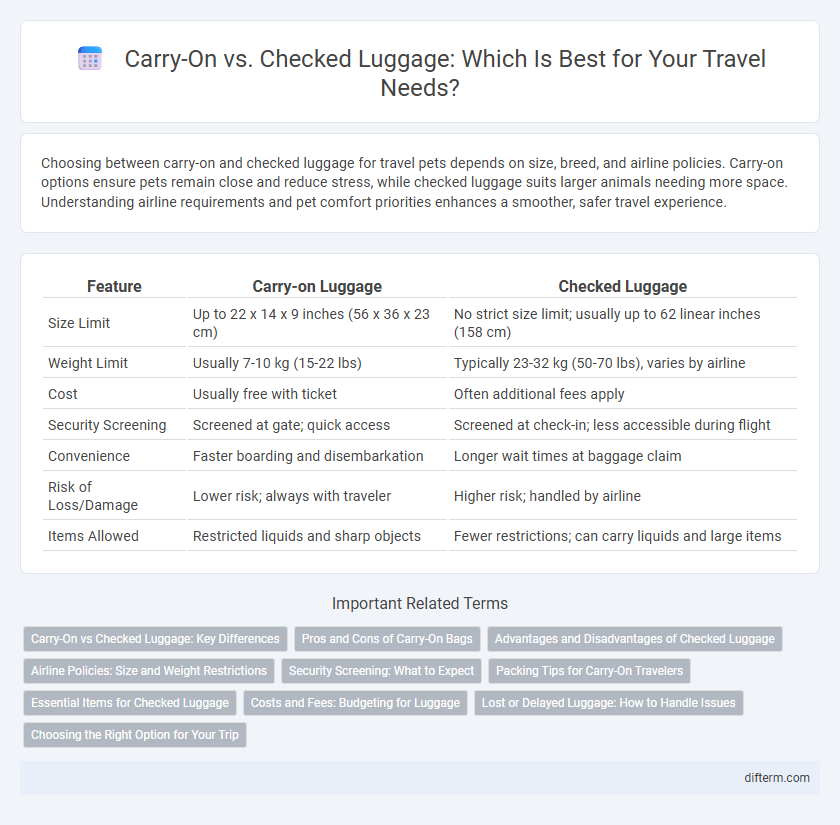Choosing between carry-on and checked luggage for travel pets depends on size, breed, and airline policies. Carry-on options ensure pets remain close and reduce stress, while checked luggage suits larger animals needing more space. Understanding airline requirements and pet comfort priorities enhances a smoother, safer travel experience.
Table of Comparison
| Feature | Carry-on Luggage | Checked Luggage |
|---|---|---|
| Size Limit | Up to 22 x 14 x 9 inches (56 x 36 x 23 cm) | No strict size limit; usually up to 62 linear inches (158 cm) |
| Weight Limit | Usually 7-10 kg (15-22 lbs) | Typically 23-32 kg (50-70 lbs), varies by airline |
| Cost | Usually free with ticket | Often additional fees apply |
| Security Screening | Screened at gate; quick access | Screened at check-in; less accessible during flight |
| Convenience | Faster boarding and disembarkation | Longer wait times at baggage claim |
| Risk of Loss/Damage | Lower risk; always with traveler | Higher risk; handled by airline |
| Items Allowed | Restricted liquids and sharp objects | Fewer restrictions; can carry liquids and large items |
Carry-On vs Checked Luggage: Key Differences
Carry-on luggage offers travelers convenience and faster airport navigation by avoiding checked baggage lines and fees, typically limited to dimensions around 22 x 14 x 9 inches and weight under 15-22 pounds depending on the airline. Checked luggage provides more packing space for extended trips or bulky items, with size allowances roughly 62 linear inches and weight limits usually capped between 50-70 pounds, but entails longer wait times and potential handling risks. Understanding airline policies and trip duration helps optimize luggage choice, balancing ease of travel with packing capacity.
Pros and Cons of Carry-On Bags
Carry-on bags offer the advantage of faster airport navigation and elimination of baggage claim waiting time, making them ideal for short trips or business travel. However, limitations in size and weight can restrict the amount of clothing and essentials packed, potentially requiring strategic organization to maximize space. Carry-ons also reduce the risk of lost luggage but may increase cabin overhead bin competition, leading to possible gate-checking delays.
Advantages and Disadvantages of Checked Luggage
Checked luggage allows travelers to carry larger and heavier items without the burden of managing them through security or boarding, providing convenience for long trips or when packing bulkier belongings. However, disadvantages include potential extra fees from airlines, longer wait times at baggage claim, and the risk of lost or damaged items during transit. Choosing checked luggage suits those prioritizing packing capacity over immediate accessibility and security checkpoint speed.
Airline Policies: Size and Weight Restrictions
Airline policies for carry-on and checked luggage vary significantly, with most carriers imposing strict size and weight limits to ensure safety and efficiency. Typical carry-on bags must not exceed dimensions of 22 x 14 x 9 inches and weigh between 15 to 22 pounds, while checked luggage often allows up to 62 linear inches and 50 pounds per bag. Exceeding these limits can result in additional fees or the requirement to check a carry-on bag, making compliance essential for smooth air travel.
Security Screening: What to Expect
Carry-on luggage undergoes more frequent and detailed security screening, including X-ray scans and manual inspections for prohibited items, to ensure compliance with safety regulations. Checked luggage is screened using advanced CT scanners and explosive detection systems, but travelers should anticipate longer processing times and restrictions on valuables inside. Understanding these procedures helps streamline airport security and reduces delays during travel.
Packing Tips for Carry-On Travelers
Maximize space in carry-on luggage by rolling clothes tightly and using packing cubes to organize essentials efficiently. Choose versatile, lightweight clothing and limit liquids to TSA-approved sizes to comply with airport regulations. Prioritize important documents, electronics, and travel essentials in easily accessible compartments for convenience and security.
Essential Items for Checked Luggage
Essential items for checked luggage typically include bulky clothing, shoes, and non-essential electronics that exceed carry-on size limits. Toiletries in containers larger than 3.4 ounces, sports equipment, and gifts or souvenirs are best stored in checked bags to comply with airline security regulations. Packing heavier items in checked luggage helps maximize space and weight allowances in carry-on bags for easier airport navigation.
Costs and Fees: Budgeting for Luggage
Airlines often impose varying fees for checked luggage, typically ranging from $20 to $50 per bag, while many allow carry-on bags for free, making carry-ons a cost-effective choice for budget travelers. Overweight or oversized checked bags can incur additional fees, sometimes exceeding $100, impacting overall travel expenses substantially. Careful planning of luggage size and weight helps travelers avoid unexpected costs, optimizing budget allocation for other travel needs.
Lost or Delayed Luggage: How to Handle Issues
Lost or delayed luggage can disrupt travel plans significantly, so travelers should always carry essential items, including medications and a change of clothes, in their carry-on bags. Reporting the issue promptly to the airline's baggage service office and obtaining a Property Irregularity Report (PIR) increases the chances of swift recovery. Using tracking apps and labeling luggage with contact information further aids in resolving delays or loss, ensuring peace of mind during air travel.
Choosing the Right Option for Your Trip
Choosing the right luggage depends on trip duration, airline baggage policies, and personal convenience. Carry-on bags offer quick access and avoid checked baggage fees but have strict size limits, making them ideal for short trips. Checked luggage provides more space for longer journeys or when carrying bulky items but requires extra time and potential fees during travel.
Carry-on vs Checked luggage Infographic

 difterm.com
difterm.com